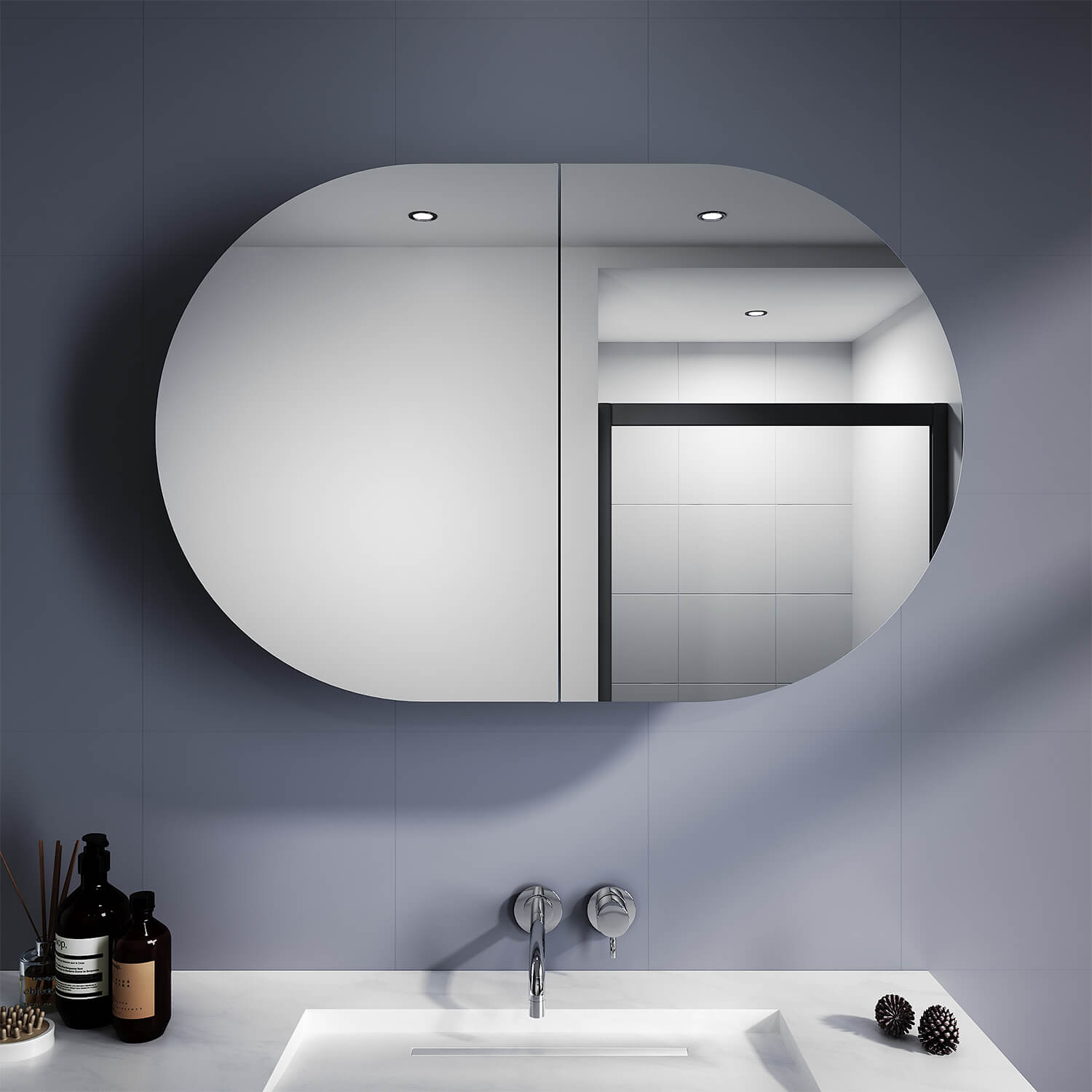With its hot and humid coastal regions along with fluctuating inland temperatures, Australia's climate presents unique challenges when choosing bathroom mirrors. High humidity causes standard glass mirrors to easily fog up after hot showers, obscuring visibility and creating an inconvenience. Finding suitable mirrors resistant to fogging is crucial, especially in bathrooms, spas, and other humid environments. The two main options available are LED mirrors and anti-fog mirrors, each with their own advantages and disadvantages.
LED mirrors feature built-in lighting around the mirror to provide optimal visibility and clarity. The LED lights heat the surface of the mirror just enough to prevent condensation from forming, making them resistant to fogging. Anti-fog mirrors have a specialized coating that prevents water droplets from forming on the surface through electrostatic and hydrophilic properties. While the anti-fog coating is effective, it wears off over time and needs reapplication.
In determining whether LED or anti-fog mirrors are better suited for Australia's climate, factors like upfront costs, energy use, longevity, and effectiveness in high humidity areas need careful comparison. The following sections will analyze these key differences in detail to provide recommendations on the best bathroom mirror solution.

Understanding Australia’s Climate and Its Impact on Mirrors
Before selecting the right type of mirror, you need to be aware of the impact that the unique climate of Australia creates on mirrors.
Humidity-prone Regions Lead to Condensation Issues
Areas like Queensland and the Northern Territory have persistently high humidity levels. When humid air meets a cool surface such as a mirror, the water vapor condenses into tiny droplets that obscure visibility - a common phenomenon after hot showers. Preventing mirror fogging is vital in these humidity-prone regions.
Energy Efficiency Important in Australian Households
Rising electricity costs and sustainability awareness means Australian households are focused on saving energy. When selecting bathroom mirrors, energy efficiency is an important consideration today. LED mirrors consume electricity, while anti-fog mirrors don't require power.
Role of Mirrors in Daily Life With High Performance Expectations
As an essential tool for grooming routines and interior design, mirrors need to provide clear reflection. Allowing mirrors to continuously fog up creates frustration and impacts people's daily lives. The chosen mirror solution must withstand Australia's challenging climate to meet high visibility expectations.

LED Mirrors: Features and Benefits
Let’s deep dive and learn more about LED mirrors.
Technology Overview
LED mirrors have built-in LED lighting encased along the perimeter of the mirror. The latest LED technology allows adjusting the light color temperature from warm white (3000K) to daylight (6000K) through dimmable controls to create the desired ambience.
With no heat emission, LEDs consume very little energy - producing up to 100 lumens per watt compared to incandescent bulbs' 10-15 lumens. Plus, the average 50,000-hour LED lifespan saves maintenance costs.
Suitability for Humidity-Prone Areas
The moisture-resistant glass and waterproof backing make LED mirrors suitable for humid environments. Sealed edges prevent steam penetration while water-tight casings carry IP44 ratings, meaning the internal electronics resist splash exposure from any direction. Although the LED bulbs emit some heat, newer LEDs distribute warmth evenly on the mirror surface without getting hot to prevent condensation. Tests show that LED mirrors suppress fogging for well over an hour even in 100% moisture bathrooms.
Pros of LED Mirrors
· Energy Savings
Consuming 80% less power than traditional incandescent bulbs, LED mirrors provide substantial energy savings over 20+ years. Their minimal heat output also reduces air conditioning demands compared to other light sources.
· Customizable Lighting
Users can set their preferred light intensity, color temperature, and create lighting zones - ideal for makeup application or ambient lighting needs. Pre-programmed defogging modes further enhance visibility.
· Modern Aesthetics
With ultra-slim profiles resembling flat-screen TVs, frameless designs, and multiple shape options, LED mirrors elevate bathroom or bedroom décor through integrated lighting and technology.
Cons of LED Mirrors
· Higher Upfront Costs
Being a value-added product with advanced lighting features, LED mirrors have significantly higher initial purchase costs than regular mirrors - ranging from $200 for smaller units to $1000+ for larger installations. Professional electrician fees may further add to costs.
· Potential for Glare
The high lumen output could cause glare in brightly-lit bathrooms during daytime depending on the positioning, hampering visibility instead of enhancing it. Proper placement is vital to minimize glare.

Anti-Fog Mirrors: Features and Benefits
Now you know what LED mirrors can bring you. With that in mind, let’s learn more on what anti-fog mirrors can deliver.
Technology Overview
Anti-fog mirrors use either passive coatings that discourage water droplets from forming or active heating systems to maintain the glass temperature above the dew point. Popular options include:
• Hydrophilic Coatings
These nanoparticle layers cause water to spread evenly into a transparent sheet instead of discrete droplets via electrostatic and intermolecular forces. They last through cleaning but wear off over 1-2 years.
• Defog Pads
Adhesive thermal pads attached to the mirror's back prevent fogging by warming 3-5°F above room temperature. Hardwired models offer adjustable heating for 10-60 minutes. Battery-powered automatic shut-off variants are also available.
Suitability for Humidity-Prone Areas
Both passive coatings and heating pads provide instant condensation resistance, maintaining excellent visibility even through lengthy hot showers or steam sessions from humidifiers. Unlike LED mirrors requiring some heat-up time, anti-fog mirrors work instantly with steam exposure. Being standalone units without vents for air circulation, they seamlessly complement existing bathroom ventilation.
Pros of Anti-Fog Mirrors
• Reliable Fog Prevention
Specialized hydrophilic treatments reliably prevent water droplets from obscuring mirror visibility in humid environments without power or heat.
• Lower Maintenance
Anti-fog coatings last through regular cleaning, while replaceable heating pads minimize servicing needs for guaranteed performance.
Cons of Anti-Fog Mirrors
• Higher Energy Use
Defogger pads consume electricity to warm mirrors, increasing energy bills. Hardwired models in particular draw more power than LED options.
• Limited Design Options
The anti-fog film and heating elements limit the shape, size and frame choices compared to LED and regular mirrors. Edgeless models are unavailable. For large mirrors, visible adapter wires along the sides detract from aesthetics.

Comparative Analysis: LED vs. Anti-Fog Mirrors
Now let’s do a comparison between LED and Anti-Fog mirrors to figure out what options is the best one available out there.
Humidity Resistance
LED mirrors rely on non-porous glass and sealed moisture barriers to prevent internal fogging. But gaps could form over time, especially in salty coastal areas, reducing resistance. Anti-fog coatings, meanwhile, provide reliable exposure protection even after years unless physically damaged.
Both perform well through routine humidity fluctuations. In extreme permanent dampness, like unventilated bathrooms, anti-fog heating elements maintain clearer visibility over prolonged periods.
Energy Efficiency
With modern LED mirrors consuming just 3 watts compared to anti-fog heat pads drawing ~50 watts, LED mirrors offer nearly 95% power savings. In households with multiple bathrooms, the energy costs of running defoggers daily could really add up over years.
However, hardwired anti-fog models provide adjustable, timed heating to minimize unnecessary usage. Solar-rechargeable battery variants further limit grid dependence.
Cost Considerations
The $500+ price tag of quality LED mirrors is 2-3 times that of basic anti-fog units. But with a 50,000-hour lifespan saving on replacement costs, LED mirrors offset their initial pricing over 5-7 years. Meanwhile, worn anti-fog coatings and heating pads would need replacements, incurring added expenses.
Many Australian states provide rebates up to $1000 for installing energy-efficient fixtures like LED lighting or low-wattage appliances to further improve ROI.
Installation and Maintenance
LED mirrors use low-voltage inputs, enabling simpler DIY installation compared to hardwired anti-fog heating pads requiring professional help. Thermal pads also demand periodic replacements after 2-3 years while LED lifespans minimize maintenance.
However, LED glass needs frequent cleaning to avoid smudges blocking light transmission unlike more durable anti-fog layers.
Aesthetic and Functional Preferences
For those preferring a modern touchscreen smart mirror effect, LED variants deliver advanced display-style personalization like color temperature changes, scheduling, and dimming - unusable in basic anti-fog models. But individuals wanting a clutter-free view may find power cords or adapter boxes in LED mirrors unsightly.
Final Words
Given Australia's humid climate, both LED and anti-fog mirrors offer reliable condensation resistance to maintain visibility after hot showers. LED mirrors leverage energy-efficient lighting to prevent fogging, while anti-fog coatings use hydrophilic properties or heating elements for clarity.
For most Australian homes seeking the optimal balance of humidity protection and electricity savings, LED mirrors are the best solution. Their sealed moisture-resistant designs suit coastal regions, while intelligent LED heating maximizes power efficiency. With rebates further reducing costs, LED mirrors deliver value over their 50,000-hour lifespan.
In extremely damp unventilated bathrooms where perpetual humidity demands active condensation prevention, anti-fog heating pads perform more dependably long-term. Their versatility also suits traditional decor preferences.
Visit the Elegant Showers Australia online shop to explore our extensive catalogue of LED and anti-fog mirrors along with expert guidance on choosing the right option for your home. Our consultants offer free humidity assessments and electrical feasibility studies to determine the best suits your climate, aesthetic, and budget. Contact us today!


